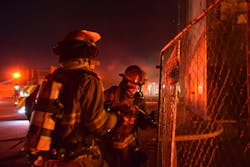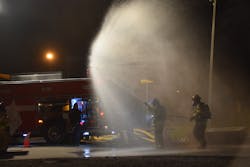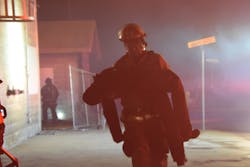Sometimes, a high call volume for a specific time frame can be predicted based on current and past trends. We also know that most residential structure fires occur between 10:00 p.m.–6:00 a.m. Even so, we understand that we can’t accurately predict when emergencies occur.
One of the time periods that affects our response capabilities and tactics is that one after the sun sets and before it rises again.
No ‘straightforward’ at night
We can predict intuitively some problems or complications that occur at night that don’t occur during the day, the first of which is low visibility because of the lack of ambient light. Some of the complications that we see as a result of low visibility are issues with size-up, potential hazards that go unseen, difficulty with choosing proper tactical deployment and problems placing equipment in service. These factors or a combination of them can make otherwise straightforward incidents much more challenging and dangerous.
Another complication that’s driven by low ambient light is the need for scene lighting. Considerations here include equipment, apparatus access to the scene and power sources. What type of lighting is preferred? How will we power it? How will we get it in position if it’s apparatus-mounted? Do the scene’s overhead obstructions permit an apparatus light tower to be raised?
Nighttime motor vehicle accidents also pose additional risks to department personnel. Motorists who, by and large, are distracted by something in their vehicle or in their thoughts will drive unaware through a scene when conditions are sunny and beautiful. At night, the situation is exacerbated significantly. Apparatus lighting, scene control using apparatus, proper use of high visibility vests/apparel by personnel and operating in the “shadow” of blocking apparatus are things that you must consider.
The last of the obvious complications, but certainly the most important of them, involves victims and rescue operations. We all know that most people are sleeping at night. Most people also are at home. Firefighters encounter a greater likelihood of finding victims who weren’t able to escape their premises during nighttime fires. As a result of this fact, a greater chance for firefighter injury exists because of rescue efforts and greater demand on resources.
Staffing
What about other, less obvious problems? Some of these are staffing levels, emergency driving, identifying available water sources, and temperature differences between daytime and nighttime hours.
Both career and volunteer departments can be affected by staffing at night. Social events and sporting events sometimes occur at night. Do these events affect who might respond if you are a volunteer agency? For career departments, who do you have for callbacks? Are chief officers available to respond to assist in establishing the incident command system and to take sector commands on larger incidents?
A good staffing plan that’s based on your department’s staffing patterns is essential.
Driving
A positive of emergency driving at night is the potential for reduced traffic. A negative is reduced visibility at some intersections or on rural roads. Can others see you? Can you see them? What part of your response area are you in? Can you expect potential intoxicated drivers in a nightlife district? What about pedestrian traffic?
A thorough understanding of the route is important for the chauffeur or engineer.
Can you see sources of water in the low-ambient-light environment? Do hydrants have reflectors on them? Is hydrant location data available on a mobile data terminal? Does the engineer or chauffeur know the area well enough to identify where static water sources are located?
Preplanning water sources throughout your response area is the only way to manage this complication of night operations.
Also, what is the weather like? In the summer, a nighttime event might provide cooler operating conditions. In late fall, winter and early spring, the colder nighttime temperatures can bring myriad problems with them.
Cold or freezing conditions pose risks that are associated with cold injuries, such as frostbite or hypothermia. These conditions require additional resources, so operating members can get warm.
The effect on equipment of various types can be severe, too. For example, an iced-up ladder has a reduced working load capacity. Pump valving and drains can freeze. Battery-powered equipment might not last the normal duration.
In addition to all of the above, icy conditions pose slip and fall risks that can cause injury to department personnel.
Night drills
All of the above leads me to the elephant in the room: If we know that night operations affect our work, why do we mostly train during the day? The answer is convenience. It simply is safer and easier to train during daylight or evening hours. Even so, this doesn’t absolve us from training at night.
Keep in mind, some training that passes for night drills only meets the minimum that NFPA 1001: Standard for Fire Fighter Professional Qualifications requires. Many departments train on operating lighting equipment. Liquified petroleum (LP) fires also are drills that we do at night. I’ll admit, LP fires look spectacular at night, with the bright orange flame and ice that we can light on fire, but they don’t prepare us for the main events—structure fires, technical rescues, hazmat incidents and extrications—that occur at night.
At the Illinois Fire Service Institute (IFSI), a multifaceted and robust approach to night operations is employed.
During the academy, eight separate night drills are conducted. Each represents a milestone during a cadet’s academy experience because of when it’s scheduled.
Night drills are delivered in Week 4 and Week 6. At both points, candidates are approaching skill performance benchmarks. However, a Week 4 night drill is one of their first opportunities to respond to a more challenging set of obstacles and problems.
Academy staff create an incident that requires candidates to utilize all of their skills in a challenging, yet controlled, environment. Ladders, forcible entry, hose movement, fire control, and search and rescue are emphasized during these incidents. Multiple forcible entry problems, heavy bodies of fire and several victims are encountered, all in an attempt to push candidates to their potential.
In Week 5 of the academy, candidates are provided with the opportunity to work on areas that were found to be deficient during their Week 4 night drills.
As they round the corner into Week 6, candidates are prepared to face their greatest challenge to date: the Week 6 night drill. It’s a very challenging coordinated fire attack mock response.
If their Week 4 night drill was in the two-story taxpayer-style burn facility, then their Week 6 night drill is in a six-story burn tower, and vice versa. These drills emphasize the same skills that were tested in Week 4 along with the addition of VEIS operations and multiple simultaneous runs.
It’s easy to look at what I described and become skeptical. Questions should rightly come to mind about safety and overaggressive training regimens. This type of training does carry additional inherent risks, but I assure you that there is a safe way to deliver these skill challenges.
The candidates prepare in drills days and/or weeks before the event. Every skill challenge that’s presented during a night drill is introduced to the candidates and practiced previously. That said, no academy or technical rescue class is the same, so candidate abilities are assessed honestly, and then the drill is scaled accordingly.
Fire loads that are inside of the structure are established beforehand to ensure that they aren’t excessive. IFSI leadership staff strictly enforce rules for controlling fire loads in the burn facilities.
The candidate-to-instructor ratio is kept low (3:1), and additional safety personnel are deployed to each level or section of the building. EMS personnel and equipment are on site. When candidates begin to reach the limits of their abilities, the drills are scaled back to ensure safety, and challenges are removed.
In the end, the drills meet the candidates where they are in their learning curve and push them toward greater proficiency in the nighttime environment.
More firefighter development
The night-operations environment creates some obvious challenges and some not so obvious. The only way to adequately prepare for them is to train in the night environment. Training in daylight is important and can help you to prepare for night operations, but training in the dark, in safe and measured ways, is critical to improving firefighter effectiveness and safety.
About the Author
James Childers
James Childers started his career in the fire service in 1995 with the Cairo, IL, Fire Department. That was followed with a tenure as an EMT with Alexander County, NC, EMS in 1996. During that time, he became an EMT-paramedic. In 2005, Childers joined the Champaign, IL, Fire Department, where he is a captain/training officer. He joined the Illinois Fire Service Institute (IFSI) in 2012. Childers serves as an IFSI Fire Academy instructor and battalion chief, the latter for seven years.


